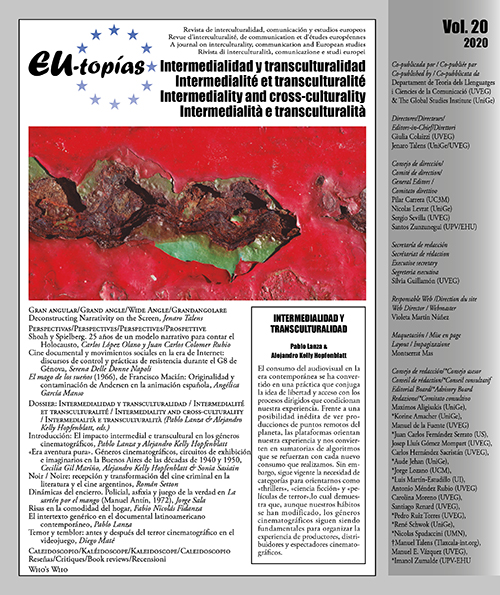The Wizard of Dreams (1966), by Francisco Macián: Originality and contamination of Andersen in Spanish animation.
DOI:
https://doi.org/10.7203/eutopias.20.19388Keywords:
Andersen, animation film, literature-cinema adaptation, Macián, Spanish cinema. Abstract
Abstract
The Spanish animated film The Wizard of Dreams (1966), directed by Francisco Macián, is based on the story Ole Lukøie, by Hans Christian Andersen. Throughout seven stories, the film blends other texts of the Danish writer, the tradition of European children’s stories and Macián’s own, as well as the influence of world animated cinema. The result is an original work and, at the same time, a work which reveals Andersen’s imprint. In the article we analyse each of the short stories, little jewels of Spanish animation, which show the puppets of the TV Telerín family, together with the processes of mise en abyme and metanoia present in the film.
 Downloads
Downloads
 References
References
Andersen, Hans Christian Cuentos completos. Madrid: Cátedra, 2012.
Artigas, Jordi Francisco Macián. Els somnis d´un mag. Barcelona: Filmoteca de Catalunya / Raval Edicions SLU / Pòrtic, 2005.
Brun, Birgitte. «Symbols of the Soul – Fairy Tales». Edd. Birgitte Brun, Ernst W. Pedersen & Marianne Runberg. Symbols of the Soul – Therapy and Guidance Through Fairy Tales. London & Philadelphia: Kingsley, 1992, pp. 5-16.
Candel, José María. Historia del dibujo animado español. Murcia: Editora Regional de Murcia, 1993.
Costa, Jordi. Películas clave del cine de animación. Barcelona: Robinbook, 2001.
Cruz Delgado = Delgado Palomo, Cruz. Mágica aventura. Madrid: Ediciones Alonso, 1983.
García Padrino, Jaime, ed. Andersen, “Ala de cisne”: Actualización de un mito (1805-2005). Madrid: Secretaría General Técnica del Ministerio de Educación y Ciencia, 2005.
Manzanera, María. Cine de animación en España – Largometrajes 1945-1985. Murcia: Universidad de Murcia, 1992.
Martínez Barnuevo, María Luisa. El largometraje de animación español: análisis y evaluación. Madrid: Fundación Autor, 2007.
Mendoza Fillola, Antonio. El intertexto lector. El espacio de encuentro de las aportaciones del texto con las del lector. Cuenca: Universidad de Castilla-La Mancha, 2001.
Mínguez López, Xavier. «El papel de la animación en el desarrollo de la competencia literaria». Elos: Revista de Literatura Infantil e Xuvenil, 2, 2015, pp. 155-172.
Rotellar, Manuel. Dibujo animado español. San Sebastián: Festival de Cine de San Sebastián, 1981.
Seguí Morey, Miquel (2000). «Pioners de l´animació a l´Estat Espanyol». Temps Moderns. Papers de Cinema, 65, 2000, pp. 24-25.
Solana Pérez, Lucía. «La Sirenita, sus versiones cinematográficas y su aplicación en el aula». Andersen, “Ala de cisne”: Actualización de un mito (1805-2005). Ed. Jaime García Padrino. Madrid: Secretaría General Técnica del Ministerio de Educación y Ciencia, 2005, pp. 169-177.
Yébenes, Pilar. Cine de animación en España. Barcelona: Ariel, 2002.
VV. AA. Monográfico Hans Christian Andersen. CLIJ, 44, 1992.
Zipes, Jack. The Enchanted Screen: The Unknown History of Fairy-Tale Films, New York: Routledge, 2011.
Downloads
Published
How to Cite
-
Abstract581
-
PDF (Español)473
Issue
Section
License
![]()
The authors conserve the copyright. All content published in EU-topías. Journal of interculturality, Communication, and European Studies are subject to the license Creative Commons Attribution-NonCommercial-ShareAlike 4.0 license. The full text of the license can be found at <http://creativecommons.org/licenses/by-nc-sa/4.0>
They may be copied, used, disseminated, transmitted and publicly displayed, provided that:
- The authorship and original source of the publication is cited (journal, publisher and URL of the work).
- They are not used for commercial purposes.
- The existence and specifications of this license of use are mentioned.
It is the responsibility of the authors to obtain the necessary permissions for images that are subject to copyright.



